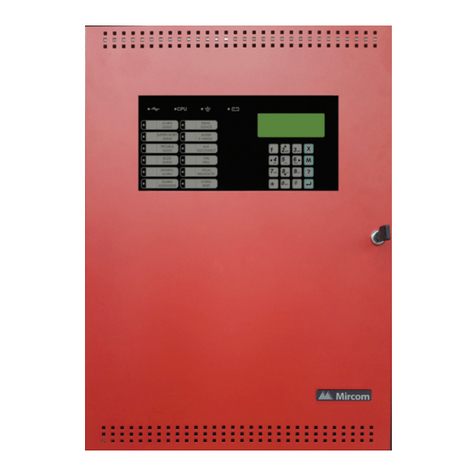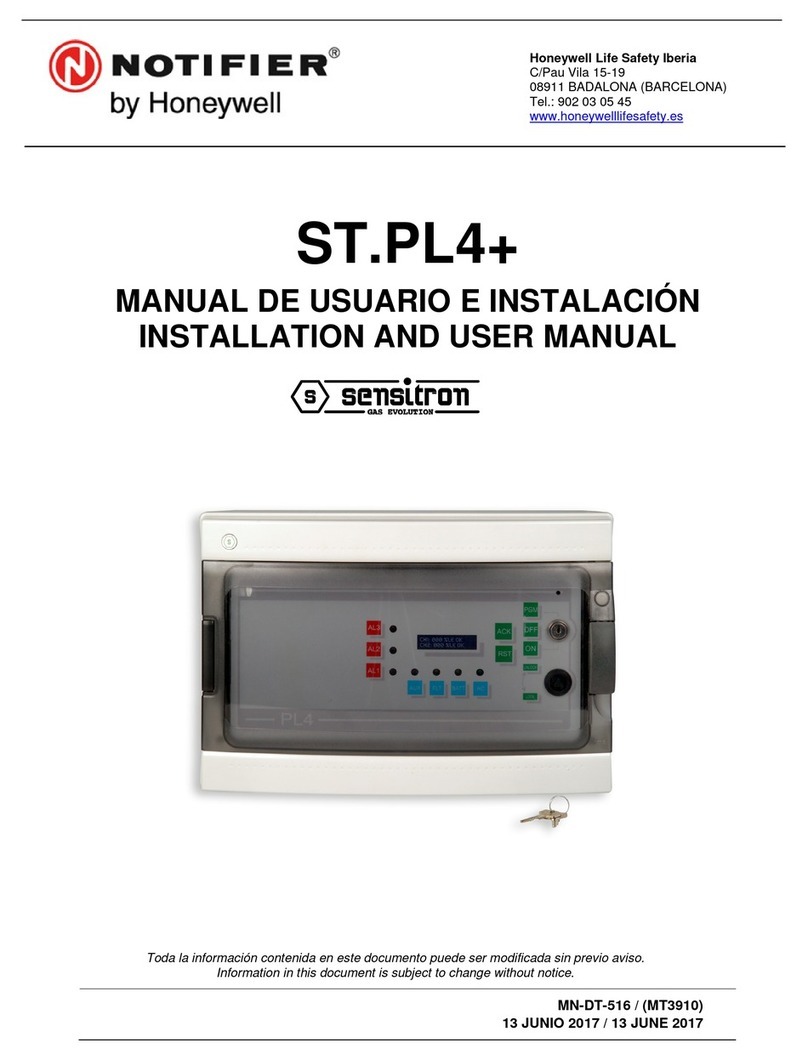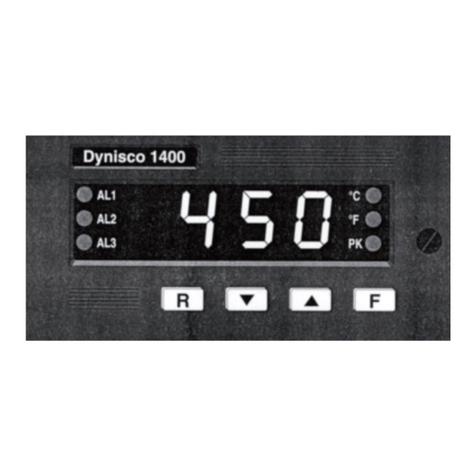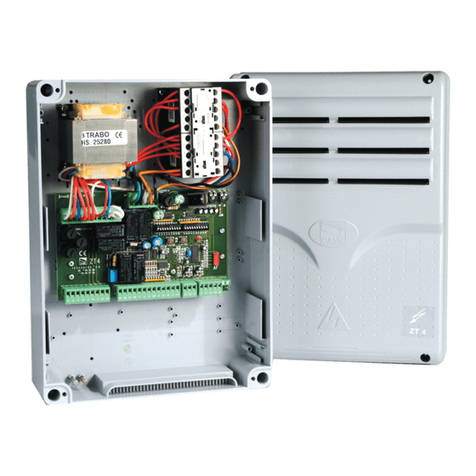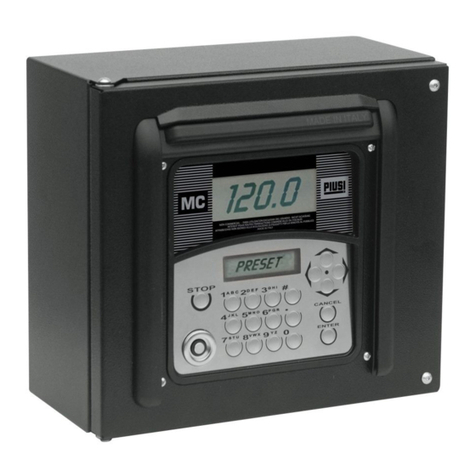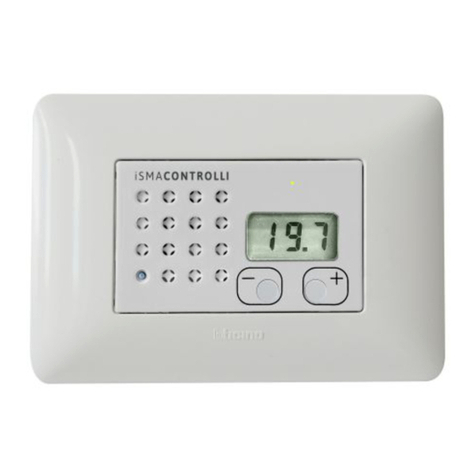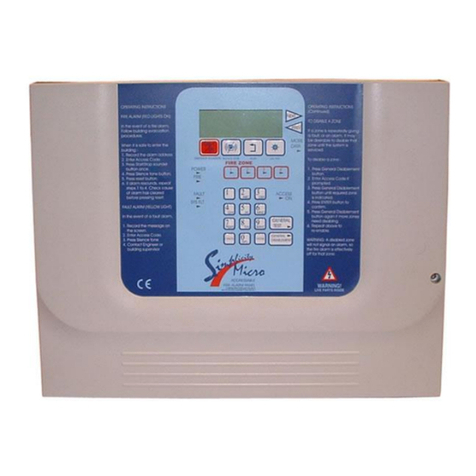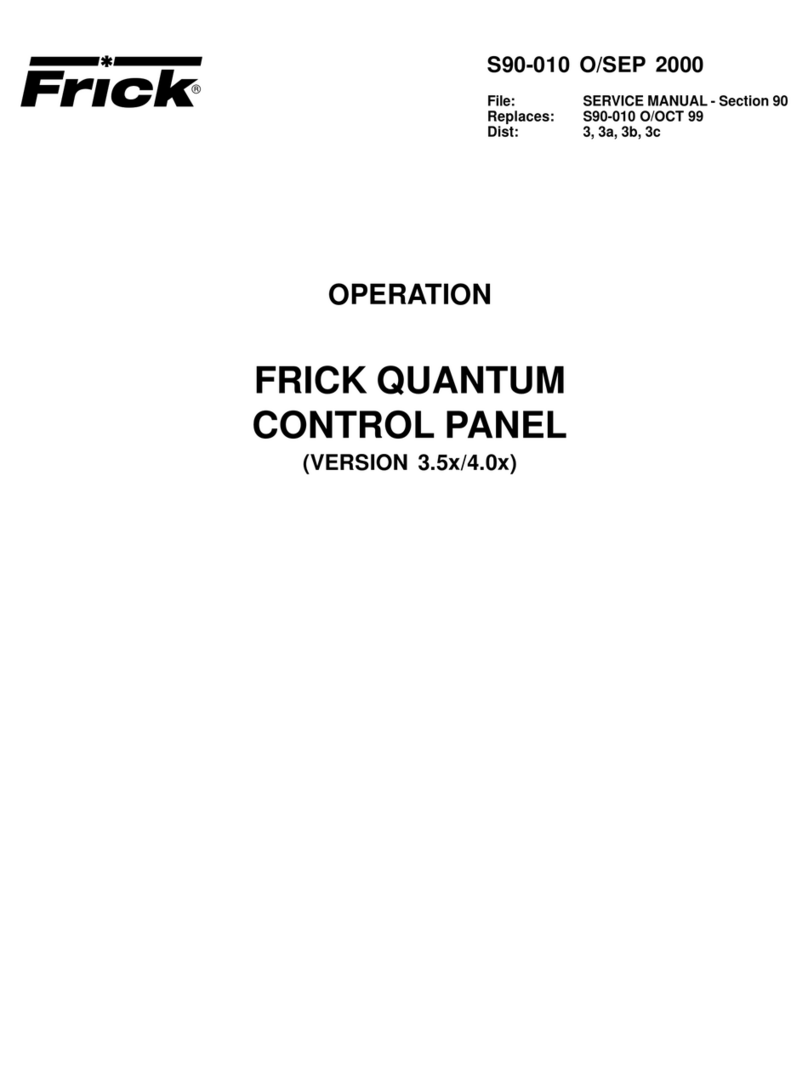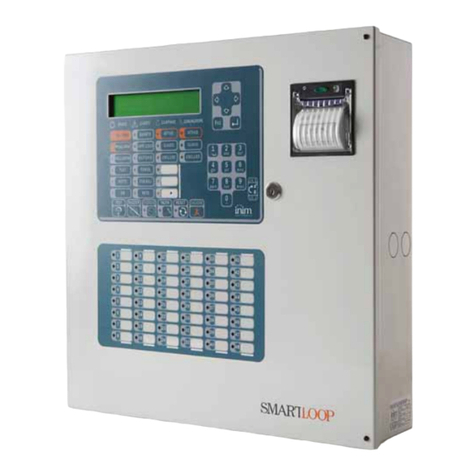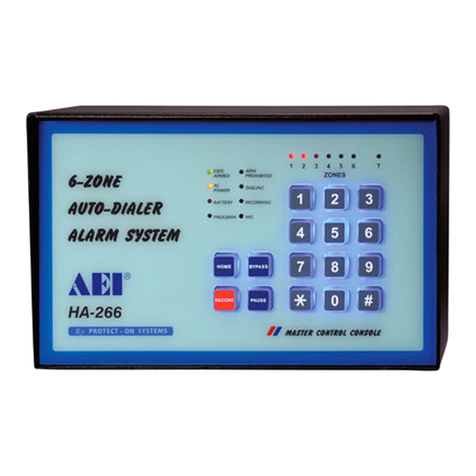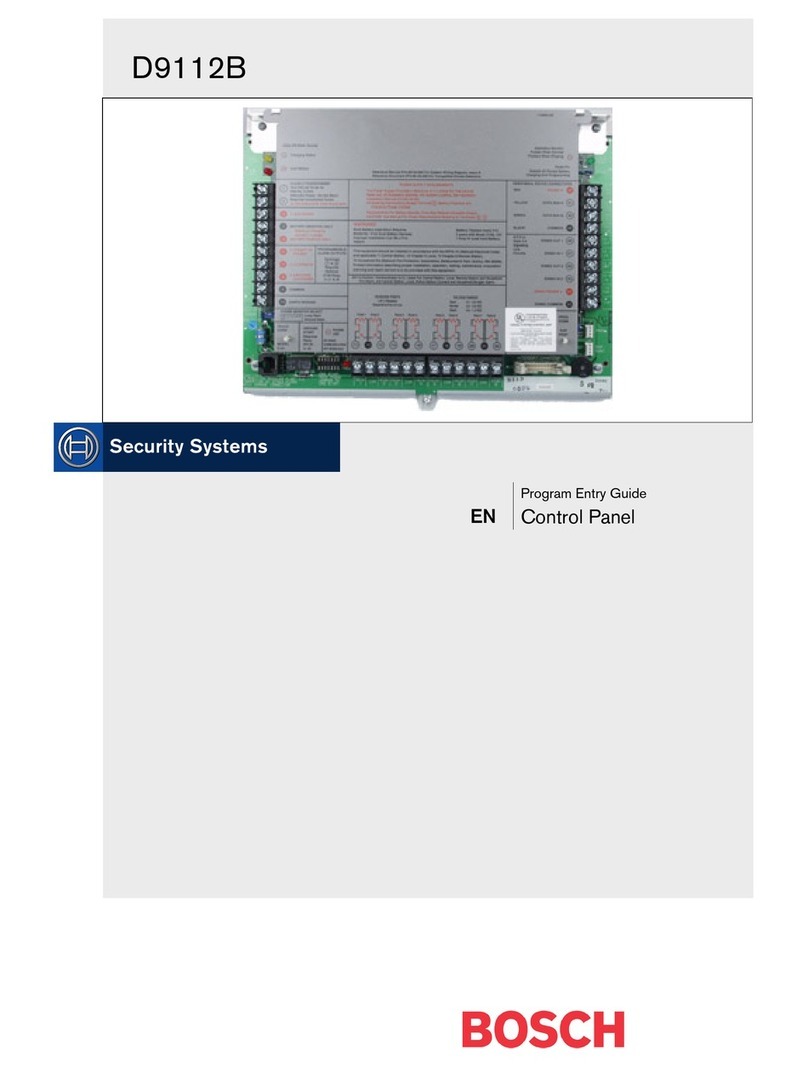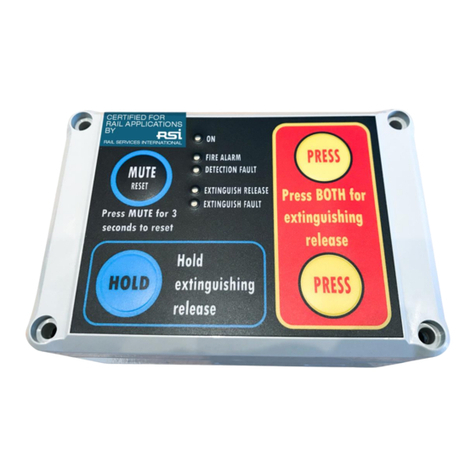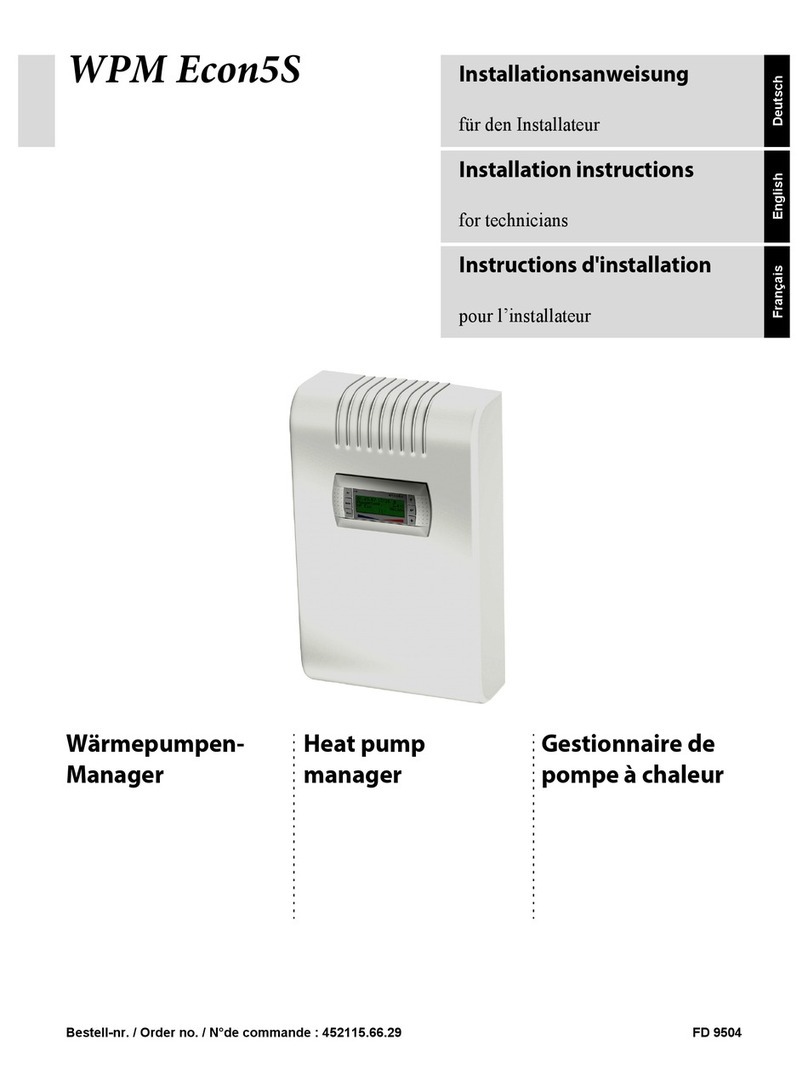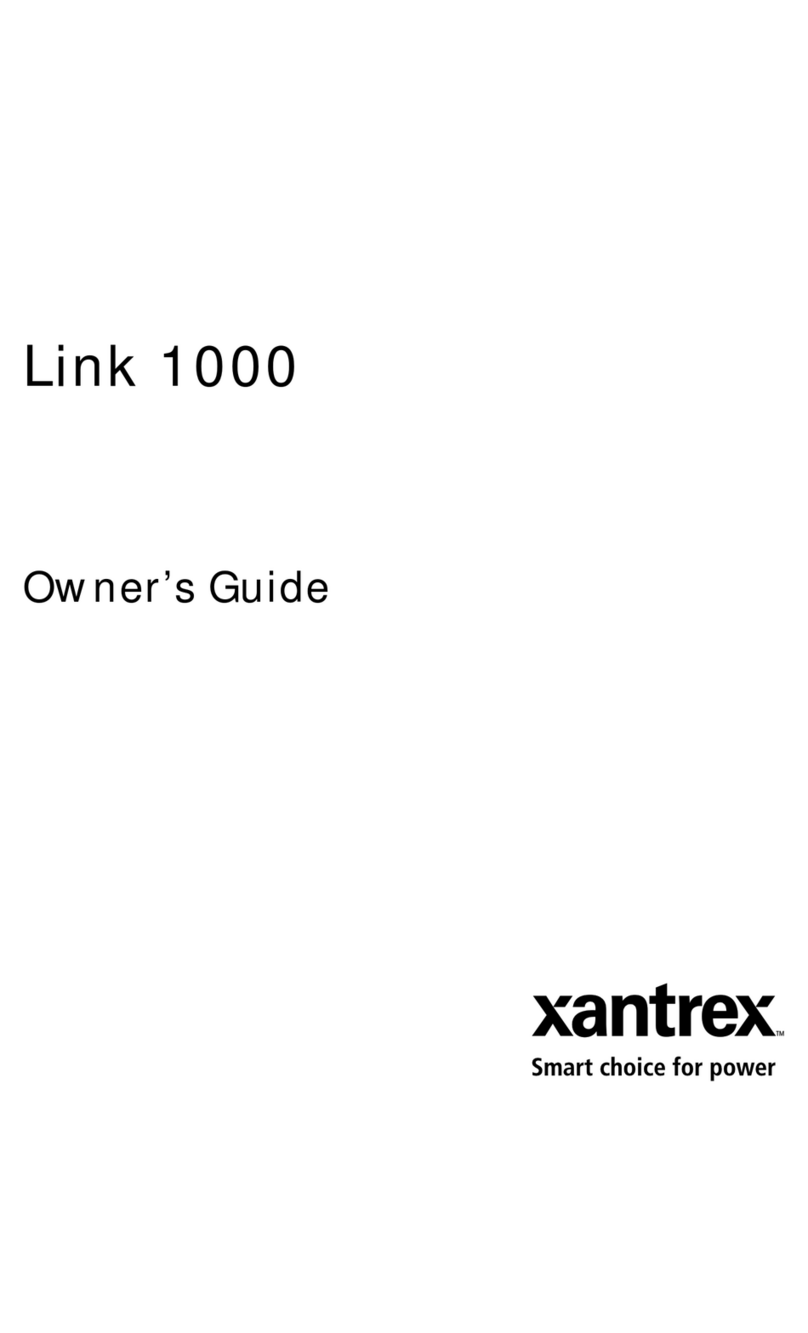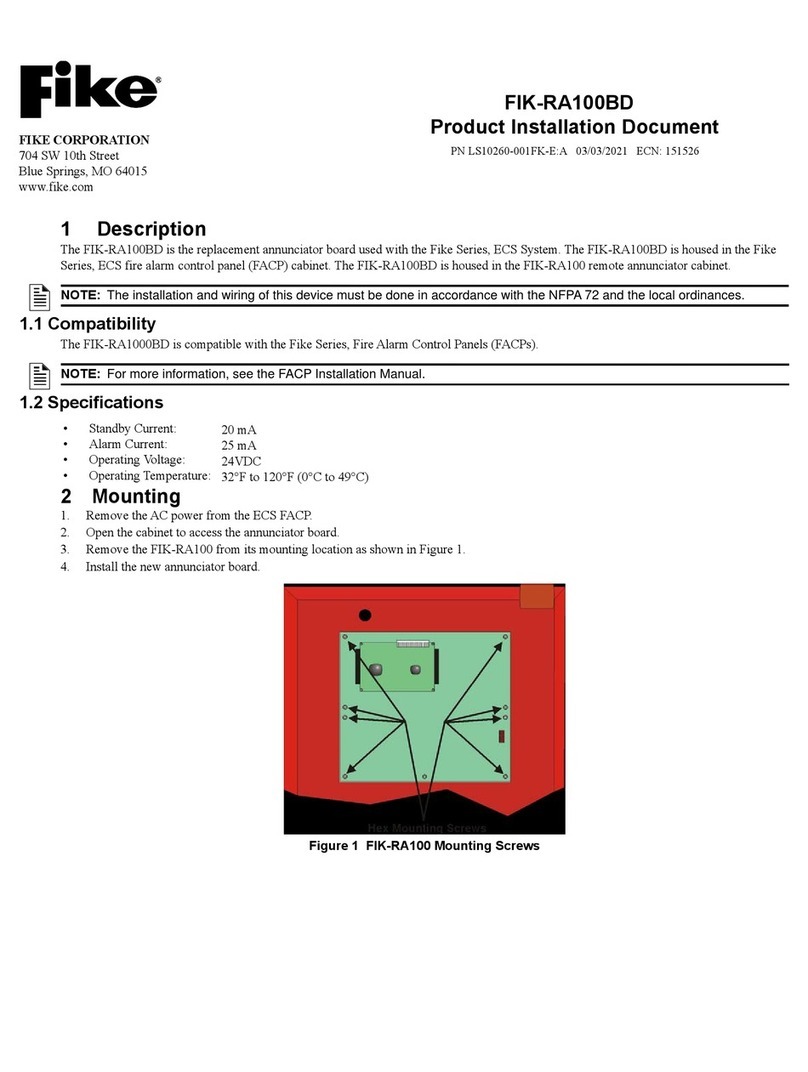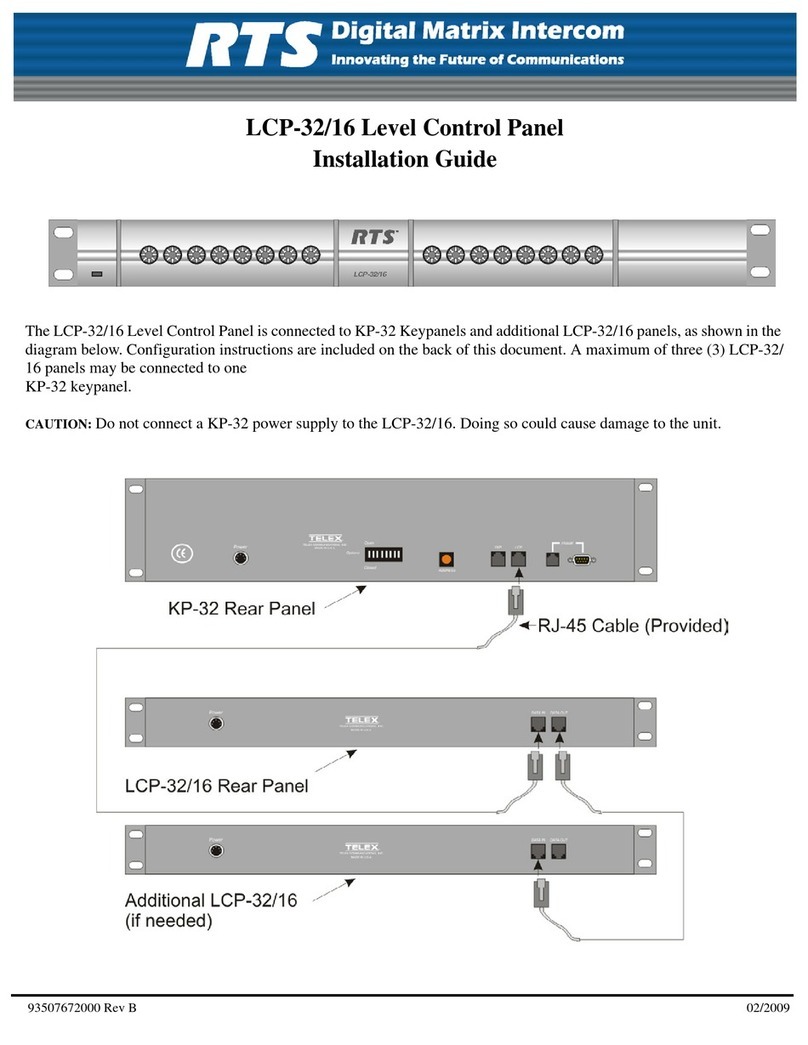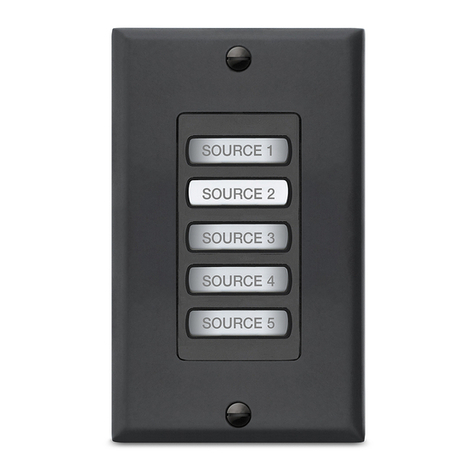Spraying Systems AUTOJET 1750+ User manual

AutoJet® 1750+
Spray Control Panel
OWNER’S MANUAL
ML001750PLUS
spray.com

1. Preface ······························································· 3
1.1 Important ·······················································3
1.2 How To Use This Manual································3
2. Safety ································································· 3
2.1 General Safety Informaon····························3
2.2 Unpacking The System ···································4
3. 1750+ Overview··················································· 5
3.1 Features··························································5
3.2 Specicaons··················································5
3.3 Plug and Spray Connecons···························7
3.4 Remote Connecons······································8
3.5 Screen Buons and Icons·······························8
3.6 HMI Operaon—Set Spray Parameters ·········9
3.7 Acvang Recipes ··········································9
4. 1750+ Home Screen Sengs······························ 10
4.1 Home Screen Sengs ··································10
4.2 Purge and Clean Sengs······························10
5. General Sengs················································· 11
5.1 Sengs Screen·············································11
5.2 Users Management Sengs ························12
5.3 User Groups··················································14
6. Supply Air To The System··································· 15
6.1 Adjustments and Operaons ·······················15
7. Applicaon Sengs··········································· 16
7.1 Spray Nozzle Sengs ···································16
7.2 Recipe Sengs ·············································20
7.3 Spray Timing Modes·····································21
7.4 Fixed Spray Time ··········································22
7.5 Variable Spray Time ·····································24
7.6 Duty Cycle·····················································27
7.7 Trigger ··························································28
7.8 Tank Level (Level Sensor) ·····························29
8. Faults and Alarms ·············································· 30
8.1 Faults and Alarms Sengs ···························30
9. Maintenance and Troubleshoong ···················· 31
9.1 Maintenance and Troubleshoong Tab ·······31
10. Diagnoscs ······················································ 33
11. Faults and Troubleshoong······························ 33
TABLE OF CONTENTS
12. Trigger devices and Accessories ·························· 36
12.1 Electric Nozzle Cord Set······························· 36
12.2 Trigger Cable················································36
12.3 Photoelectric Object Sensor ························ 37
12.4 Color Sensor················································· 37
12.5 Proximity Sensor·········································· 38
12.6 Trigger Interlock··········································· 38
12.7 Foot Switch ·················································· 38
12.8 Hand Trigger Pendant·································· 39
12.9 Thru-Beam Sensor ·······································39
12.10 Laser Sensor (Short)···································· 40
12.11 Laser Sensor (Long)····································· 40
12.12 Fault Output Signal····································· 40
12.13 Fault Output cable Kit·································41
12.14 Extension Cable ··········································42
12.15 Input Signal·················································42
12.16 Level Sensor Input ······································43
12.17 Trigger Devices Overview··························· 43
13. Spare and Replacement Parts ····························· 44

3
1.1 IMPORTANT
This AutoJet® Spray Control Panel and all components are produced, tested and checked at the factory. The system
can be dangerous if used incorrectly. Read this manual carefully and read all safety instrucons.
Operators must always follow the general safety instrucons in the working area and aim to prevent accidents.
The manufacturer reserves the right to make changes in standard construcon without prior nocaon.
Images and diagrams in this manual may not be exact representaons of your system conguraon.
1.2 HOW TO USE THIS MANUAL
This manual is intended to be a source of informaon for the operators and/or technicians who may be installing, in-
teracng with, or servicing/maintaining Spraying Systems Co.® systems and components.
This manual contains important safety warnings, installaon/operang instrucons, and troubleshoong/
maintenance informaon.
ICONS
WARNING: The user can be seriously injured, damage their health, and/or damage the system.
CAUTION: Product, process, or environment can be damaged or be in danger if the instrucons are
not followed correctly.
ATTENTION: Supplementary informaon for the user that draws aenon to possible problems.
2.1 GENERAL SAFETY INFORMATION
READ AND FOLLOW INSTRUCTIONS
All safety related and operang instrucons should be read before the system is operated. Follow all operang in-
strucons.
SERVICING
Do not aempt to service this system unless you have been trained or authorized to conduct repairs. Only authorized
and qualied service personnel should aempt to service this system. Service by unauthorized personnel will void any
warranes.
WARNING: Before performing any maintenance, make sure electrical power is o and that any air
and liquid pressure is bled from the system.
REPLACEMENT PARTS
This system has been designed with components that work together to provide the best system performance. When
replacement parts are required, only Spraying Systems Co.® recommended components should be used to maintain
proper system operaon, electrical and pneumac safety. The use of any unauthorized replacement parts will void
any warranes.
UNINTENDED USE
Use of Spraying Systems Co.® equipment in ways other than those described in the documentaon supplied with
the equipment may result in injury to persons or damage to property. Examples of unintended use of equipment:
SECTION 1
PREFACE
SECTION 2
SAFETY

4
• Using incompable materials
• Making unauthorized modicaons
• Removing or bypassing safety guards or interlocks
• Using incompable or damaged parts
• Using unapproved auxiliary equipment
• Operang equipment in excess of maximum rangs
REGULATIONS AND APPROVALS
Make sure all equipment is rated and approved for the environment in which it is used. Any approvals obtained for
Spraying Systems Co. equipment will be voided if instrucons for installaon, operaon, and service are not followed.
All phases of equipment installaon must comply with federal, state, and local codes.
PERSONAL PROTECTIVE EQUIPMENT
Spraying Systems Co. strongly recommends the use of appropriate safety equipment when working in potenally
hazardous environments and chemicals. This safety equipment includes, but is not limited to, the following:
• Protecve hat
• Safety glasses or face shield
• Chemical-resistant or safety gloves and apron
• Long sleeve shirt and long pants
Users of this product should never place themselves in the path of the resulng spray. Users should consult and follow
the recommendaons of the Safety Data Sheet (SDS) of any chemical or uid sprayed using this system.
PRESSURIZED SYSTEMS
It is important to recognize proper safety precauons when using a pressurized spray system. When dealing with
pressure applicaons, the system pressure should never exceed the lowest rated component. Always know your
system, all component capabilies, maximum pressures, and ow rates.
WARNING: Fluids under pressure can penetrate skin and cause severe injury.
ATTENTION: Always remember to carefully read the chemical manufacturer's labels, follow SDS and
all direcons.
WARNING OF SHOCK HAZARD
To reduce the risk of electric shock, do not open the cover on electrical control panel. For service contact
Spraying Systems Co.® at 1-866-321-2250.
WARNING: Plug panels into a GFCI outlet.
WARNING: To prevent injury, avoid contact with potenally hot parts. Components can cause severe
burns. Do not aim the spray at any person or part of the body. Do not place any part of your body in
the spray paern.
2.2 UNPACKING THE SYSTEM
The system components come carefully packaged to protect them from damage. Use cauon when opening the crate.
The crate will contain all parts needed to install the unit. Parts of the unit may be wrapped in bubble wrap. Remove all
of the packaging material wrapping the system. Once unpacked and removed the from the crate, the system is ready
for installaon and connecon.
CAUTION: The packaging may contain exposed cables, hoses, or other components. Always exercise
cauon when opening boxes to avoid accidental damage or slicing of various components.

5
SECTION 3
1750+ OVERVIEW
The AutoJet® 1750+ Spray Control System featuring an HMI Touch Screen Display is a self-contained, electronic/
pneumac panel that provides control of various aspects of a spray system. These systems come in a variety of design
conguraons depending on the requirements of your spray applicaon, therefore, you may or may not have all the
features described in this owner’s manual.
3.1 FEATURES
The Spraying Systems Co.® AutoJet 1750+ Spray Control System is a self-contained unit that can provide you with
precise liquid delivery and spray nozzle control in an aordable easy to use turn-key spray system. The system comes in
a variety of designs and conguraons based on the type of spray nozzle used in your applicaon.
The system can be used with water, oils, lubricants, inks, stains, water-based solvents, and non-abrasive slurries. The
system is designed to spray most non-ammable or non-volale materials. Liquids and materials that ow with
viscosies below 1000 cP at 68°F (20°C) can be sprayed with the correct spray nozzle and controlled with this unique
spray system soluon.
SYSTEM USAGE
• The AutoJet 1750+ Spray Control System is designed to run connuously or intermiently.
• The AutoJet 1750+ Spray Control System features a high-quality HMI touchscreen interface.
— The user can set and control dierent spray ming such as; spray period, start delay, and stop delay mes.
• The controller is designed to run both electric and air actuated spray nozzles.
— Can drive Spraying Systems Co. electric-actuated spray nozzles (3.6 amps. max.) with Pulse Width Modulaon
(PWM). Specically, the PulsaJet® spray nozzle line and the AA250AUH Electric spray nozzles can be used.
— PWM (Pulse Width Modulaon) is a technique used to control ow rate by rapidly pulsing the nozzle on and o
and uses a duty cycle within the spray me. Duty Cycle (DC) is the percent of me of the total cycle me the
nozzle is spraying. If the nozzle is spraying 50% of the me, the DC is 50% thus the ow is ½ that of the nozzle
being fully open.
3.2 SPECIFICATIONS
• 4.3” HMI Touch Screen display unit featuring custom programming.
• UL Type 1, stainless steel control panel.
• Stainless steel enclosure, wash-down with door closed, not explosion proof (Non-Ex).
• Power ON/OFF switch with Power on LED indicator light.
• Power input 110-230VAC, 50/60, 1 ph., 2.2A (Plug into a GFCI outlet).
• Global compability Mul-voltage power cords available
• Power cord, 6 . (2m) length.
• Output 24 Vdc
• 3.6 amps dedicated to electric spray nozzles and sensors
• Wireless access point.
• Inputs for 1 analog input, 3 digital inputs and 3 digital outputs.
• Includes digital output for air atomizing solenoids.
• Oers dual digital inputs for conveyor interlock type trigger.
• Features local and remote triggering opons.
• Independent ming ranges for spray and delay adjustable from 0 to 20,000 seconds.
• Delays for atomizing air (ancipator and follower mes) can be set 0 to 10 seconds.

6
• 1 – 100% duty cycle adjustment for PulsaJet and other electric spray nozzles.
• Oers easy to use ming modes of Fixed Spray Time; Variable Spray Time, and Repeat.
• Can control and drive up to ten (10) Spraying Systems Co.® electric spray nozzles
• AA10000AUH-03 PulsaJet® spray nozzles – Ten (10)
• AA10000JJAU PulsaJet air atomizing spray nozzles – Ten (10)
• AA10000AUH-10 PulsaJet spray nozzles – Three (3)
• AA10000AUH-30 PulsaJet spray nozzles – One (1)
• AA250AUH Electric spray nozzles – Ten (10)
• Ambient temperature rangs for electric control panel:
• 41°F Minimum (5°C)
• 104°F Maximum (40°C)
• Dimensions: 9” (228.6 mm) x 4 1/4” (108 mm) x 10 1/2” (266.7 mm)
For Internaonal applicaons be sure that you have the correct power cord.
PRECISION SPRAY CONTROL (PSC)
The PulsaJet® automac spray nozzle is an electrically-acvated hydraulic, atomizing nozzle. This nozzle sprays the
product in a controlled way using a PWM algorithm to control the sprayed amount without aecng the spray angle.
PWM is the fundamental control principle that allows a signicant reducon in ow by regulang the relaonship
between the on/o mes that the nozzle operates.
Short pulses of on-me and longer pulses of o-me produce a spray paern that appears connuous, but actually
reduces the overall ow delivered to the target surface. This provides beer ow control with larger spray ps that are
less prone to clogging. The droplet size is aected by the pressure of the liquid. With PSC, the droplet size and spray
angle are independent of the liquid ow because the nozzle can work at the same liquid pressure for variable liquid
ows.
PSC involves switching the spray nozzle on and o repeatedly at a controlled rate, called the modulang frequency.
The modulang frequency is the number of mes the nozzle is switched on and o in one second and is measured in
Hertz (Hz). If a spray nozzle is switched on and o 10 mes per second, the modulang frequency is 10 Hz. The me
from when the nozzle turns on to the next me the nozzle turns on is called the period, in this case 1/10th of a second.
Within a single period, the nozzle is switched on, then o. The me that the nozzle is on, divided by the total me of
the period, gives a percentage which is called the duty cycle. For example, if the period is 0.10 seconds, and the nozzle
is on for half of that me, then the duty cycle is 50%. For the same period, if
the nozzle is on for 0.08 seconds then the duty cycle is 80%. Therefore, at an
80% duty cycle, the ow will theorecally be 80% of the maximum ow rate
(= 100% ow rate) at a given pressure for the nozzle. Using PSC, the ow rate
for a spray applicaon can be easily controlled without the need to adjust the
spray pressure or spray p.

7
3.3 PLUG AND SPRAY CONNECTIONS
All the connecons are the same as the full system. Located on the boom of the panel the connecons are as follows.
• Power input connecon, route power cord through oval opening on right-hand side of frame and plug in 120 VAC
outlet rated for at least 5A.
• 4-20 mA - Remote Duty Cycle Input. Analog input is accessible through this connecon.
• Main - Nozzle Liquid ON/OFF connecon. Use this output for the connecon on all electric spray nozzles and
cylinder air.
• Trig - Is the input connecon for the system trigger or sensor. Connect cable to Trig connecon that will be used to
start spray sequence. Available triggers are as follows, the one used should be based on the customer’s applicaon.
- Trigger cable (for use with customer-supplied trigger signal)
- Sensors including: object, proximity, laser (short/long), thru-beam, and full spectrum color sensor.
- Hand-held trigger unit
- Foot switch
• Aux - Nozzle air ON/OFF for fan and atomizing air control.
• T. int. - Used for the oponal trigger interlock or level switch input. Trigger Interlock controls the state of run/
standby mode.
PLUG AND SPRAY COMPATIBILITY
The 1750+ can be mounted to the universal frame with mobile cart. Plug and Spray provides quick hook up for all
nozzles, an Air Control Package (ACP), triggers, and any other compable SCS Series accessories including a level
switch, an interlock cable, and the remote setpoint cable. Plug into GFCI outlets.
POSITION OR MOUNT THE SYSTEM
Find a convenient locaon for the 1750+ AutoJet® Spray Control System within a reasonable distance of your spray
applicaon and easily accessible to a properly grounded power outlet. The unit must be installed when the cord is
connected, the plug can be easily reached and easy to remove from the outlet.
- Determine if the unit will be free-standing or wall mounted.
CONTROL PANEL ONLY VERSION
If you have the Control Panel Only version the unit should be wall mounted.
Install wall anchors that are designed to support at least 25 lbs., according to the anchor manufacturers’ specicaons.
The mounng holes are on 5 7/16” (138 mm) centers and are made for 1/4” (6 mm) screws with 3/8” (10 mm)
diameter screw heads. Secure the Model 1750+ to its selected locaon.

8
3.4 REMOTE CONNECTION
Users can connect to the 1750+ with a mobile device via Wi-Fi to create an access point. Once set-up is complete, you
can adjust sengs, view alarms, troubleshoot, review maintenance schedules, and more on the connected mobile
device. The 1750+ Preventave Maintenance (PM) scheduler allows the user to set various maintenance reminders by
months or number of cycles. An alarm will appear on the HMI when the maintenance is due.
SMART DEVICE CONNECTION SET-UP
1. Go to the Play Store or Apple App store and download a VNC viewer app, such as RealVNC Viewer.
2. Power on the 1750+ (if system is not already on).
3. In Wi-Fi sengs on your mobile device, locate the Wi-Fi SSID, typically SSCO_xxxxxx. Select connect and enter the
default password of SSCO1750.
4. Open VNC Viewer and connect to the 1750+ at: 192.168.0.20:5900.
Note: There is a chance that your network administrator blocks this type of connecon.
Side Bar Navigaon
Navigate to home screen.
Navigate to sengs screen.
Navigate to diagnoscs screen
Navigate to alarms screen, turns orange with
an acve alarm present.
Switch to a dierent user.
Top Bar Status Informaon
Navigate to about screen.
Recipes
Displays current system status.
Reset Alarm
Screen Buons
Field is editable
Toggled On
Toggled O
Standby or Run
Trigger
3.5 SCREEN BUTTONS AND ICONS

9
RECIPES
Preprogrammed recipes can be accessed quickly from any screen by selecng the recipe secon of the top bar.
The recipe sengs secons contains four tabs. The drop down list near the top if the page allows you to select which
recipe you would like to view, edit, or apply as the current spray parameters. The 1750+ is capable of storing up to 20
user-created recipes.
3.6 HMI OPERATION—SET SPRAY PARAMETERS
1. Set the system to manual mode. Disconnect the nozzles. Set all pressure regulators to 0. Turn on the main air
pressure and increase liquid pressure gradually to ush the system. Everything is now ushed except for the nozzles.
2. Connect the nozzles and set the pressure regulators to the required pressure and then check if there are any
leakage.
3. If the nozzle type isn’t set, go to the Spray Nozzle Sengs secon of this manual.
STARTING THE SYSTEM
1. Verify the system status is in “Run” mode. (top bar, right corner)
2. If not, press “run” buon unl the system is in “RUN” mode.
3. Be sure a recipe is selected If you have purchased the oponal soware upgrade and the desired PWM setpoint is
set in the recipe (between 1% and 100% depending on your applicaon).
3.7 ACTIVATING RECIPES
A recipe is a pre-congured set of parameters that allows you to change to a dierent producon batch quickly. These
parameters cover most of the ming and spray sengs.
By default, your new 1750+ control panel has simple ming to operate your PulsaJet electric spray nozzles. As an
oponal item, you can unlock the recipe funcon on your new 1750+ controller which allow you to setup and save
dierent ways to spray each batch.
If you purchase the recipes funconality at a later date, you will receive an unlock code that you can enter directly into
the 1750+. You access this by clicking on the sengs icon/users, then click in the space shown below and it will ask for
the code. Enter the code and recipes will be unlocked.
A recipe can be loaded by selecng it from the dropdown menu and clicking “Apply” to transfer the sengs to the
1750+. If you edit the currently selected recipe, you must press “Apply” again for the changes to be applied.
Enter recipe code in the box at the boom of the screen.

10
4.1 HOME SCREEN SETTINGS
The home screen at the top and side bars will always be visible and accessible.
Setpoint: Displays the congurable mode in the applicaon you are set in.
Nozzle status: Displays the current nozzle spray status as a percentage of the maximum ow rate.
Atomizing air status: Atomizing Air Status and spray status are read-only representaons of the current status. Adjust atomizing
air in sengs, and toggle the spray status by using the run or trigger buons.
Spray status: Shows whether the nozzle is currently spraying or not.
Clean/Purge: Access or trigger the clean and purge cycle sengs.
STANDBY/RUN
Using this Toggle buon, you can swap between Run and Standby
states.
• Run: The system will spray if it is triggered.
• Standby: The system will stop spraying and will not react to a
new trigger signal.
If the system is busy spraying, it will nish the “follower” for the air
output to cleanly stop spraying.
TRIGGER
The trigger buon is only shown if the trigger source has been set to “Buon on home screen” in “Trigger sengs”.
Depending on your sengs, you will have:
• Fixed spray mode, Momentary buon (single shot mode): starts a spray when clicked.
• Variable spray mode, Toggle buon: starts & stops a spray when clicked.
4.2 PURGE AND CLEAN SETTINGS
The Purge and Clean cycles can be toggled on or o with their labeled On/O indicators at the boom of the screen. A
blue indicator with the dot on the right-hand side shows the currently selected and acve cycle.
PURGE
The purge cycle is used to empty the uid lines of liquid, or as an addional way to drain a tank or pressure pot.
The purge cycle automacally sets the nozzle duty cycle to 100% (fully open) and requires the operator to manually
turn the cycle on or o using the labeled indicator. The cycle will connue unl it is manually turned o. The other
values are not editable while the purge cycle is acve.
CLEAN
The clean cycle is commonly used to clear a nozzle that appears to
be clogged and requires the operator to set three editable values.
These values include:
• Clean Duty Cycle — Set between 1–100%
• Max Cycle Speed — Set between 60–5,000 cycles/minute
• Clean Time — Set between 1–250 seconds
1750+ Home Screen
SECTION 4
1750+ HOME SCREEN
Purge and Clean sengs screen

11
General Sengs and Applicaon Sengs are the two sengs in the 1750+. General sengs are related to the spray
control panel itself and include sengs that relate to operators and interacon with the 1750+.
5.1 SETTINGS SCREEN
The 1750+ allows operators to manage users and user sengs, change the language (where applicable), view system
informaon, and view the acvity log.
LANGUAGE
Here you will be able to change the language of the user interface text if available.
ABOUT SCREEN
This screen displays informaon about your system. You can nd the following informaon in the about screen:
• Spray controller serial number
• Spray controller soware version and revision number
• Spray controller/panel upme
• Current date/me
SECTION 5
GENERAL SETTINGS
Sengs Screen
About screen

12
ACTIVITY LOG
Displays a log of which parameters were changed by which user.
This log is stored locally in the panel but can be deleted or exported to a USB Sck. Used for troubleshoong.
5.2 USER MANAGEMENT SETTINGS
The 1750+ allows you to edit or create your own users so that each person who interacts with the system can have
their own personal login details. The 1750+ tracks all changes to crical sengs and records, which users can make
these changes; this informaon is available in the acvity log. Users within the User Group cust_admin can view these
acvity reports on the 1750+ or export the acvity report via a USB sck.
Note: When the system is started for the very rst me, and for every reboot thereaer, it boots up to “default” (user)
which has admin rights and can edit all sengs.
ATTENTION: A system restart is required to apply any changes made to user sengs.
Note: Should it ever be required, you can contact your Spraying Systems Co.® representave to receive instrucons on
how to perform a total system reset to factory sengs.
Switch User
Sign out the current user by signing in a new user, or sign in a user. This screen will also appear when selecng the
users icon on the le-hand menu bar.
Users buon
User management screen
Login or switch user screen
Acvity Log Screen

13
Add User
Create a new user and assign them to a User Group. Ensure
that you use the drop-down menu to pick the correct user
group. Select “Add” to add the user to the 1750+ user list.
Add user screen
Edit User
Edit the selected user’s properes. You can change the
user’s password for them, or change their User Group.
Edit user screen
Sengs
The Sengs opon within Add new user gives you
addional opons.
You can:
• Require the new user to change their inial password
on their rst login
• Change how long the new user may remain logged in
without any acvity
• Seng the value to 0 will leave the user logged in unl
they choose to log out, or the system is rebooted.
Add new user—sengs
Change Password
Allows you to change the password of the user that is
currently logged in. Enter the user’s current password, and
then enter the desired new password. Select “Change” to
conrm the acon.
Change password screen
Delete User
This screen allows a created user to be deleted. You must
select the username and group of the user you want to
delete, then select “Delete” to remove the user.
Log Out
Yes or no choice to log out the
current user. The 1750+ will
return to the “default” user
aer someone logs out.
Log out conrmaon screen
Delete User Screen

14
5.3 USER GROUPS
The system contains four preloaded users (username and password sets) that are the factory (default) sengs. Users
can choose to use (or edit) these exisng users or create new users as they see t.
Each of these default users has a dierent level of user rights to interact with the system based on their selected User
Group. It is very important to pay close aenon to the selected User Group for each current and created user. The
table below shows the factory default users, user groups, and user rights. The minimum password length for all user
groups is four (4) characters, and all user groups have access to basic spray control panel features.
USER GROUP:
Operators
These users can trigger the system and put it in standby mode. Operators can change the duty cycle setpoint. All other
funcons are disabled or read-only for users in the operator user group.
• The factory sengs user “operator” is a member of this user group.
Cust_admin
These users have full control over all system sengs and can edit or create new users.
• The factory sengs user “admin” is a member of this user group.
Admin
There is a fourth factory sengs user “SSCO” that is included with the system in User Group admin.
This user is included as a backup opon to reset User Group cust_admin passwords if they are lost.
Do not use the “SSCO” user for daily operaon of the unit. User Group admin and User Group cust_admin have the
exact same access rights.
ATTENTION: A system restart is required to apply any changes made to user sengs.
DEFAULT USERNAME:
Inial startup and all reboots of the system will load into the factory sengs “default” user prole.
Under factory sengs, the user “default” is within the user group default, which has the exact same level of access as
user group cust_admin.
• With factory sengs, this user has full control over the system and can edit or create new users.
• Users can edit this user to change its access level.
• Can be changed to user group “operator” to remove edit access.
• Can set an Inacvity logo me to require someone using the system to log in with their personal credenals aer
a set period of me.
Factory (Default) User Rights and Sengs
Default
Username
Inial
Password User Group
Log O
Time (min)
Advanced
Features
Edit/Add
Users
Reboots to
User
operator oper operators n/a
default default cust_admin n/a xxx
admin admin cust_admin 15 xx
SSCO 60189 admin 15 xx

15
SECTION 6
SUPPLY AIR TO THE SYSTEM
6.1 ADJUSTMENTS AND OPERATIONS
1. Turn the red valve on the air inlet valve/regulator/lter clockwise to the on posion. Turn regulator that is on top of
the air lter to an air pressure between 40-100 psi (2.8-6.9 bar). Air pressures higher than this will shorten the life
of the pump.
2. Adjust the regulated air pressures (regulators on front panel).
• If applicable, depending on your spray system you may have anywhere from Liquid Pressure regulaon only to
Liquid Pressure; Pump Air (preset); Atomizing Air (drop size); Fan Air (spray angle/paern).
Each air control line is equipped with a manual air pressure regulator. The regulators can be adjusted by rst pulling
up on the knob to unlock the regulator and then turning clockwise to increase and counterclockwise to decrease
the pressure.
When the proper air pressure is reached, press down on the knob on the regulator to lock it in place.
Note: Your system is equipped with cylinder air for air actuated spray nozzles. Cylinder air pressure is equal to the
inlet air pressure to the system. It is not regulated; therefore, you must provide a minimum of 45 psi (3.1 bar) to the
system. It must be above 45 psi (3.1 bar) to actuate air actuated nozzles like Spraying Systems Co.® 1/4JAU series.
5. Adjust the Liquid Pressure regulator. For pump version ensure that the pump inlet air valve is in the “open”
posion. The regulator can be adjusted by rst pulling up on the knob and then turning clockwise to increase and
counterclockwise to decrease the pressure. When the proper liquid pressure is reached, press down on the knob to
lock it in place.
1750+ Home Screen
Color Code: Aux
Pin # Color Descripon
1Brown +24 VDC
2white N/A
3Blue Air Output
4Black N/A
4 1
3
Air Connecon Specicaons
Female

16
Applicaon sengs are related to your spray applicaon, and will allow you to customize the spray parameters to
achieve the desired spray coverage and ow rates. These sengs will also allow you to congure certain 1750+
accessories, such as the trigger interlock and remote duty cycle if they are included in your specic conguraon in
later chapters of the text. This Applicaon Sengs secon explains the Spray Nozzle Sengs, Conguraon, Duty
Cycle, Trigger, and Tank Level Sensor Sengs.
Note: Applicaon Sengs and Recipe Sengs are the same. Use recipe funcon to congure most sengs if the recipe
feature is included in your system conguraon.
7.1 SPRAY NOZZLE SETTINGS
The Nozzle Sengs page allows for the eding of the Nozzle type and Cycle Speed.
—Nozzle type: nozzle family selecon, atomizing air selecon, and ancipator/ follower me.
—Cycle speed: allows for the eding of the minimum and maximum cycles per minute.
SELECTING NOZZLE TYPE:
—Nozzle Family: Select the type of nozzle supplied with your system.
—Enable Atomizing Air if your system requires air atomizing.
—Advanced Nozzle Sengs allows for eding the PWM sengs.
SECTION 7
APPLICATION SETTINGS
Eding Nozzle Type
Nozzle Sengs Screen
Applicaon Sengs
Color Code: Main
Pin
#Color Description
1Brown PWM +
2white Fault
3Blue PWM -
4Black N/A
Main Connecon Specicaons

17
DISTANCE BASED SPRAY TIMING
The xed and variable spray length ming modes have an alternave in which distances are used instead of me.
These modes are called xed spray distance and variable spray distance. In these modes, delays are expressed in
distance units. These are the units that were chosen when calibrang the frequency input.
The ancipator me in this mode has a special behavior, it is converted to a distance using the maximum speed,
meaning that it is a minimum ancipator me. At speeds below the maximum speed, it will be longer.
ANTICIPATOR/FOLLOWER TIME
The system will start spraying when it receives a “trigger” signal and stop when the trigger signal is removed.
If your system is equipped with an air atomizing nozzle the 1750+ will switch the air output on before it starts spraying
to allow the spray paern to develop fully. When the system stops spraying, the air will connue for a short period
aer to guarantee no large droplets can drip o of the nozzle. These mes always reference from the spray ming.
Max me for both is 10 s.
Note: The ancipator me must not be shorter than the start delay me set in the ming sengs.
When a spray paern is generated where the o me < (ancipator me + follower me), the air output remains on
for the duraon of this paern.
Overlapping anticipator / follower sequence
Ancipator-Follower

18
PARAMETERS—ADVANCED NOZZLE SETTINGS
For custom applicaons, it is possible to change the properes of the nozzle manually. These sengs should only be
modied by instrucon from qualied SSCO personnel except for the nozzle cycle count.
WARNING: Incorrect sengs can permanently damage the spray nozzle!
Negave Pulse: Pulse me in milliseconds
• Used to speed up the closing of the electric spray nozzle, duraon is dependent on nozzle model and supply volt-
age.
Gun (Nozzle) Oset: Oset me in milliseconds
• The dierence in the opening and closing me of the PulsaJet nozzle can be corrected by using the oset value.
The default value is 0ms. For example: If the oset value is set to -1ms, the on period will be decreased by 1ms
and the o period will be increased by 1ms.
If a nozzle wear cycle count alarm has been acvated, the counter must be reset in this screen aer the nozzle has
been replaced.
Eding Advanced Nozzle Sengs

19
CYCLE SPEED
The maximum frequency parameter (fmax ) determines the maximum speed of the nozzle at 50% duty cycle and is
entered as a number of cycles/minute. This parameter can be found in the datasheet of the electric spray nozzle being
used.
The spray control panel will calculate the cycle speed to conform to the following requirements (in this order):
• As slow as possible to prevent wear of the spray nozzle.
• Correct duty cycle this means ON-me / (ON-me + OFF-me) = duty cycle.
• OFF me lower or equal than the maximum on/o me parameter. This prevents striping and very low
frequencies at low duty cycles.
• ON me lower or equal than the maximum on/o me parameter. This prevents striping and very low frequencies
at high duty cycles.
• Frequency of the signal higher than the PWM minimum cycles/min seng. This can be used to keep the frequency
constant for a large range of duty cycles.
• ON and OFF me higher than or equal to the minimum pulse width of the gun. This ensures that the nozzle is able
to open and close at the same speed as the signal.
Cycle speed sengs allows for the eding of the minimum and maximum cycles per minute, as well as the spray
thickness. Maximum cycles speed is 7,500 cycles/min, minimum range is 0-60 cycles/min.
• Maximum cycle speed: Maximum speed that the nozzle should switch at for this applicaon. This entry will be
limited by the type of nozzle selected.
• Minimum cycle speed: Minimum cycle speed for the 1750+ is recommended for this applicaon.
Note: If you want a constant cycle speed, enter a large spray thickness, and use the minimum cycle speed as your
required cycle speed entry. The 1750+ will then cycle at this speed whenever possible.
Cycle Speed Example:
For a nozzle that can achieve 10,000 cycles/min, the minimum pulse width is 3ms. This ensures that the combinaon
of duty cycle and cycle speed falls within the triangle curve of the PulsaJet® electric spray nozzles (See gure below).
The triangle is the approximate operang range of the nozzle. As long as operang parameters (duty cycle and
frequency) are inside this triangle, the nozzle will operate normally. If the operang parameters are outside the
triangle, the nozzle will not operate.
Example:
Spray Nozzle: AAB10000AUH-03
• Maximum cycle speed: 10000 cycles/min
• Minimum cycle speed: 0 cycles/min (= disabled)
• Minimum pulse width: 3ms
Objecve:
• Maximum on/o me: 0.010 s or 10ms
• Duty cycle: 30%
Eding Cycle Speed Sengs

20
7.2 RECIPE SETTINGS
Recipes are an oponal feature that can be added with a fee to your 1750+. A recipe is a pre-congured set of
parameters that allows you to change to a dierent producon batch quickly. These parameters cover most of the
ming and spray sengs. Recipes can be accessed quickly from any screen by selecng the recipe secon of the top
bar, as shown in the image below.
The recipe sengs secons contains four tabs. The drop down list near the top of the page allows you to select which
recipe you would like to view, edit, or apply as the current spray parameters. The 1750+ is capable of storing up to 20
user-created recipes.
GENERAL TAB IN RECIPES
You can change the name of the recipe and create a recipe descripon using the blue pencil icon. This can allow
operators to easily dierenate between dierent recipes when changing spray parameters is required.
Recipe Sengs screen
Sengs screen with recipes enabled
Recipe sengs, General tab
Select the recipe from any screen
Other manuals for AUTOJET 1750+
1
Table of contents
Other Spraying Systems Control Panel manuals
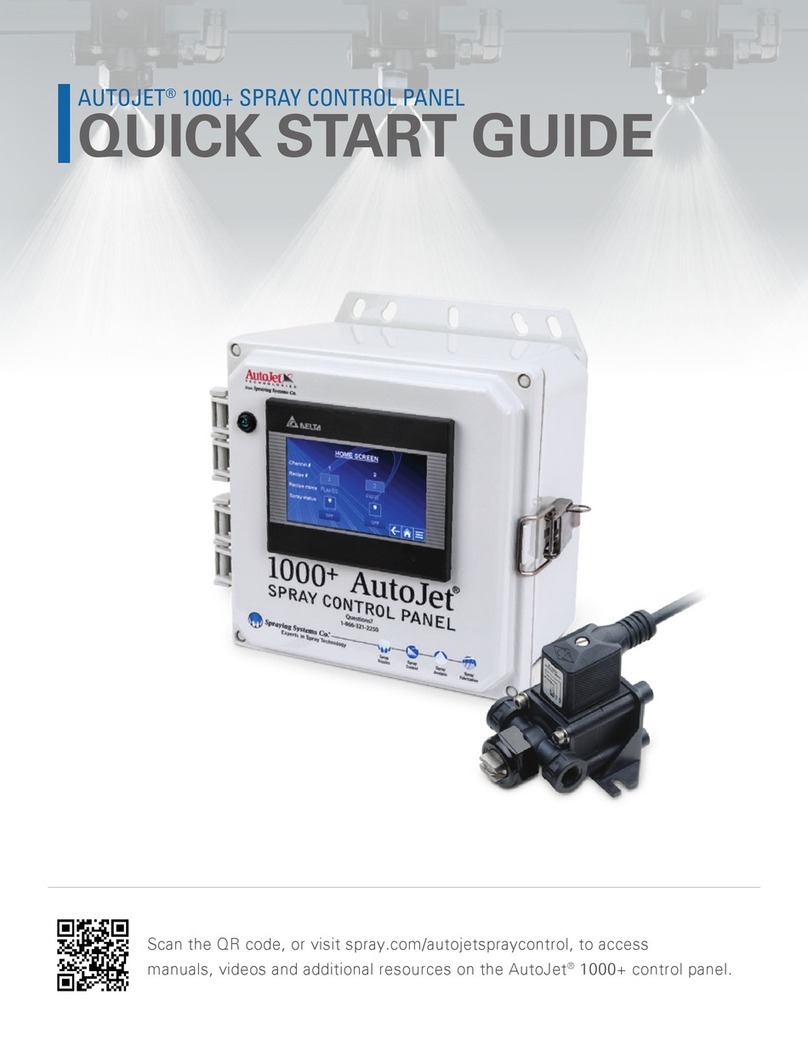
Spraying Systems
Spraying Systems AutoJet 1000+ User manual

Spraying Systems
Spraying Systems AUTOJET 1550+ User manual
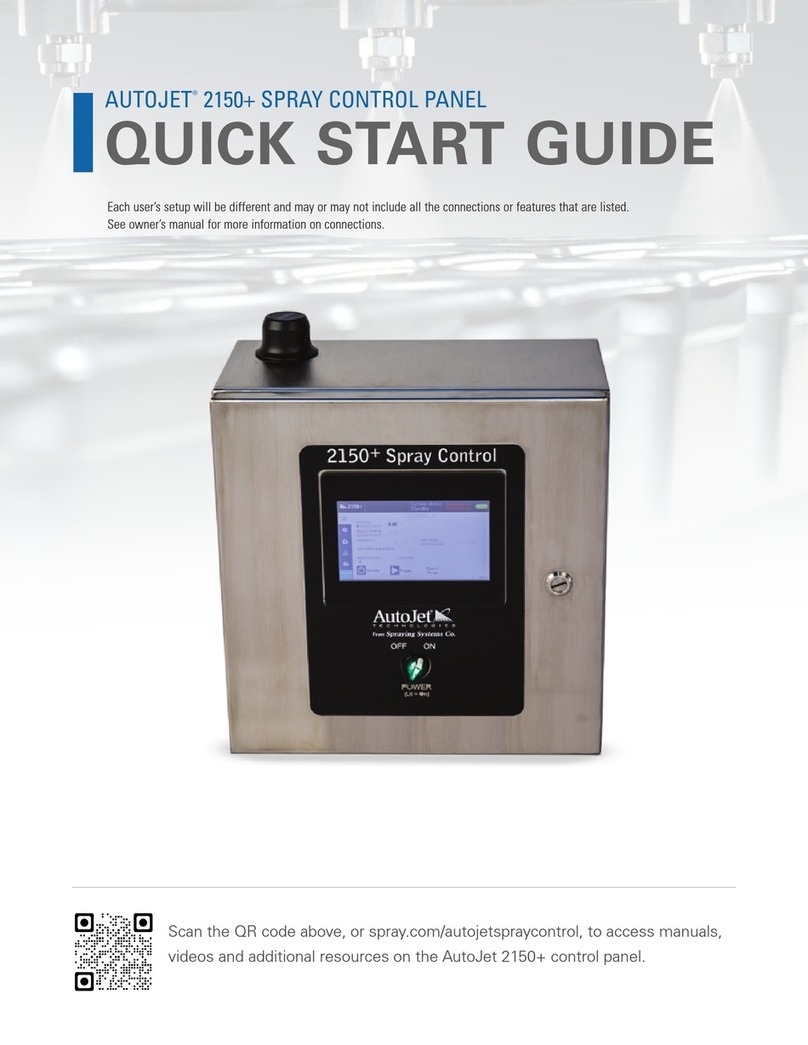
Spraying Systems
Spraying Systems AutoJet 2150+ User manual

Spraying Systems
Spraying Systems AutoJet 1000+ User manual

Spraying Systems
Spraying Systems AutoJet 2150+ User manual
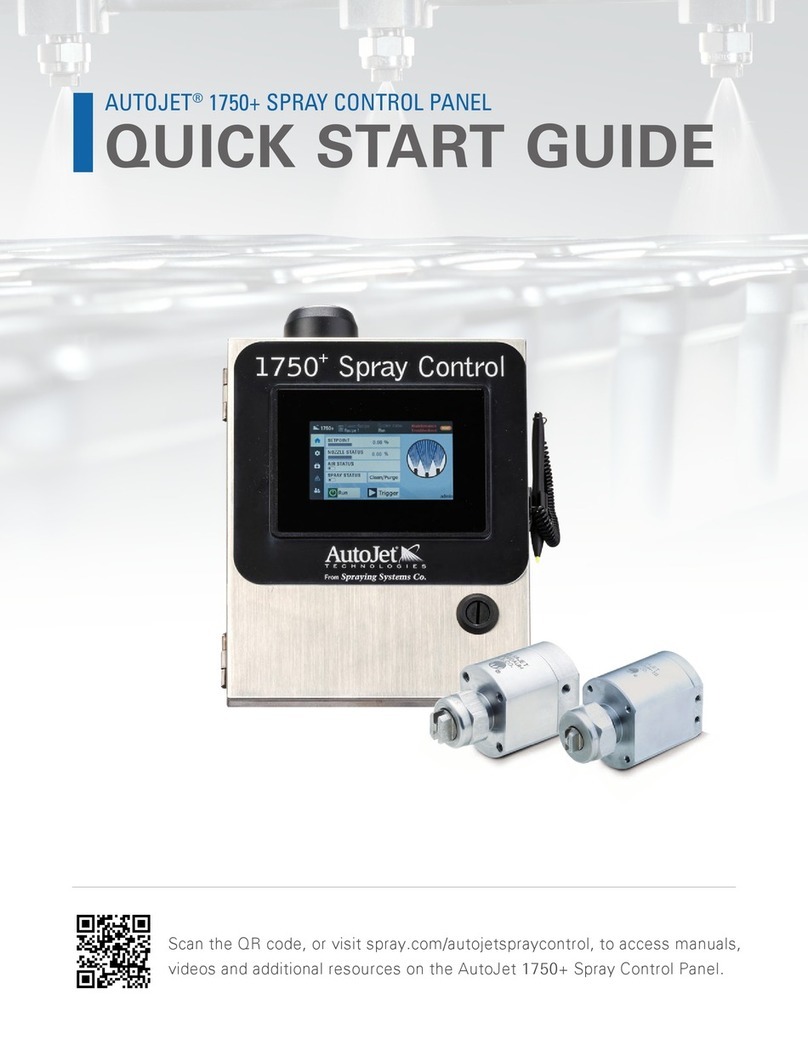
Spraying Systems
Spraying Systems AUTOJET 1750+ User manual

Spraying Systems
Spraying Systems AutoJet 1000+ User manual

Spraying Systems
Spraying Systems AutoJet 1750+ User manual

Spraying Systems
Spraying Systems AutoJet 1000+ User manual
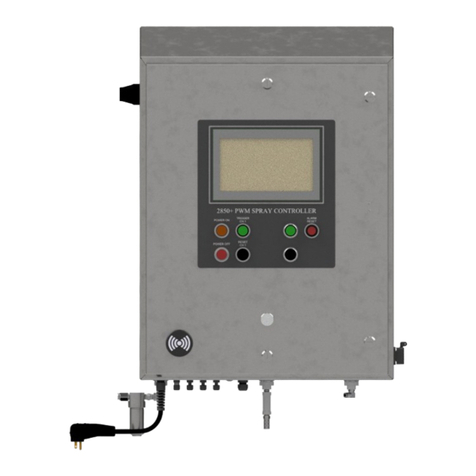
Spraying Systems
Spraying Systems AutoJet 2850+ User manual
